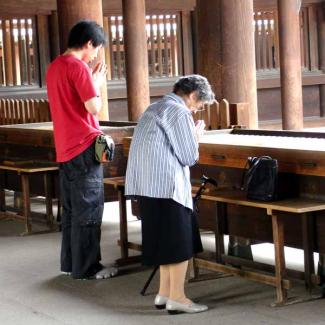My first day in Japan. Tthe Dominicans took me to visit a local Shinto shrine, Meiji Jingu. It is in Shibu-ku, Tokyo, and although it is in the center of the city, has 175 acres of woods and fields. The shrine itself sits in the middle of the woods, reached only by a long walk through quiet, wooded paths and flower gardens just coming into bloom? a great contrast to the hustle and bustle of the streets of Tokyo.
The site proclaims, "Deities enshrined: Emporer Meiji and His consort Empress Shoken." Emporer Meiji ruled Japan from 1868 to 1912. In the shrine courtyard there is a sacred tree surrounded by thousands of prayer petitions written on wooden plaques in many languages, people asking for protection for their family and friends, success in life and in relationships, and happiness and love. The young and the old come here to pray, equally reverent and hushed as they enter the shrine.
I wondered to whom they pray? What was their image of God, and could that God give them that for which they were searching? Later that day I read an article about "A Japanese Concept of God," which seemed to fit what I was seeing and feeling at Meiji Jingu. The beauty, the quiet, the ablutions in the fountain, all led me to reach out to something... the trees? the wind? the spirits? the Spirit? The specifics were very unfocussed. Just what was I reaching out to? My heart needed the thank, to ask, to acknowledge something higher, and my mind did not need to define it. I prayed at the shrine in the Shinto way, asking that I might understand their way.
Matsuo Basho described this feeling in a classic haiku:
Among the green leaves,
new buds; all glinting in the sun.
Something here demands reverence.
